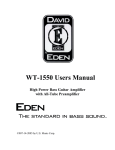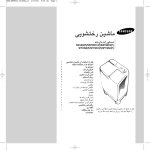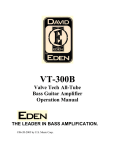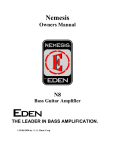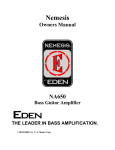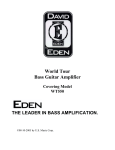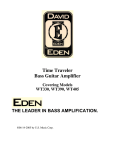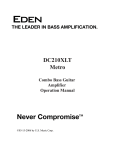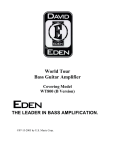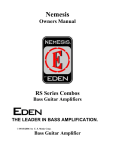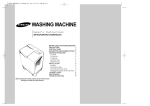Download Eden WT1250 Specifications
Transcript
EDEN THE LEADER IN BASS AMPLIFICATION. World Tour Amplifier High Power Bass Guitar Amplifier Models WT1250 and WT1550 Never Compromise™ ©02-23-2006 by U.S. Music Corp. OPERATION MANUAL For WT1250 and WT1550 High Power Bass Guitar Amplifiers Publishing Date 02-23-2006 FOREWORD Congratulations on the purchase of your new Eden World Tour Bass Guitar Power Amplifier. All of us at Eden are totally committed to providing you with the very best bass guitar systems in their class. Our goals are to offer you the outstanding performance quality of a top-notch, professional bass amplification system at a reasonable price point, and to make World Tour amplifiers the most musical and reliable Bass amplifiers available. This manual will cover domestic and international versions of the WT1250 and WT1550 amplifiers. You have purchased what we feel is one of the finest bass power amplifiers in the world. The new Tone Control section, featuring individual controls for each channel, allows the user to quickly adjust to difficult rooms. The AGC Limiter and Thermal Safety System protect your amplifier from potential damage. The compact, rack mountable package houses modular circuits made with superior components and designed for years of trouble-free service. The Eden World Tour products group is the result of our quest for ultimate bass tone and maximum reliability. Your new Power Amplifier features our latest input section, using dual pre-amp tubes to provide unequaled warmth and tonal adjustment to accommodate varying room acoustics. We believe the result is more than worth the effort and think you’ll agree. Your amplifier was designed, engineered and manufactured equivalent to aircraft vibration standards and housed in a one-piece steel case with steel top to ensure maximum reliability. The modular design allows quick repair in the field should such a need arise. 2 The Eden line of World Tour amplifiers is the result of our research and development in combining high performance and compact size. Just as a skilled craftsman needs good quality tools that won't let him down on the job, so does a good musician. We hope you enjoy the tool we’ve created for you. Have fun; play low! Please read this manual in its entirety before operating your new amplifier. Failure to do so could result in misuse or damage. We’ve taken the time to write it, which was a lot longer than the time it will take for you to read it. Help us help you by taking a few moments to learn how to properly use your new amp. You’ll be glad you did! CAUTION! Your ears are your most important piece of equipment. Unfortunately, they cannot be replaced as easily as your other gear. Please take the following warning seriously. This product, when used in combination with loudspeakers and/or additional amplification may be capable of producing sound levels that could cause permanent hearing loss. DO NOT operate at high volume levels or at a level that is uncomfortable. If you experience any discomfort or ringing in the ears or suspect hearing loss, you should consult an audiologist. Thank you for your purchase of an Eden bass guitar product. This unit has been designed and constructed to give you years of trouble-free service. Please take the time to review this manual and to send in your warranty registration card. 3 GENERAL SPECIFICATIONS WT1550: Size Weight EIA rack Power Output Bridge Mode Headroom Damping Factor Freq. Response Distortion THD 3.5” x 19” x 14.5” 32 Lbs. 2 Space w/ min. clearance @ 8Ω: 2 x 300 Watts RMS; @ 4Ω: 2 x 600 Watts RMS; @ 2Ω: 2 x 750 Watts RMS (Both channels driven) @ 8Ω: 1200 Watts RMS; @ 4Ω: 1550 Watts RMS +3dB min. better than 100 from 20Hz to 1Khz 10Hz to 20KHz +/- 2dB < .1 % Power Requirements – The WT1550 needs a separate properly grounded 20 Amp circuit @ 120 Volts for correct operation and best sound quality. FOR YOUR SAFETY DO NOT REMOVE OR MODIFY THE GROUND ON YOUR POWER CABLE. Fuse Requirements: USA @ 120 Volts /60 HZ - 14 Amps, 5 x 20 mm GMC/T/slow blow Europe @ 240 Volts/50 Hz - 7 Amps, 5 x 20 mm GMC/T/slow blow Japan @ 100 Volts/60 Hz - 15 Amps, 5 x 20 mm GMC/T/slow blow Operation and Power Requirements – For best electrical operation and sound quality this unit should have a properly grounded, dedicated 20 Amp circuit for itself. WT1250: Size Weight EIA rack Power Output 3.5” x 19” x 14” 28 Lbs. 2 Space w/ min. clearance @ 8Ω: 2 x 300 Watts RMS; @ 4Ω: 2 x 500Watts; @ 2Ω: 2 x 625 Watts RMS (Both channels driven) Bridge Mode @ 8 Ohms: 1000 Watts RMS; @ 4Ω: 1250 Watts RMS Headroom +3dB min. Damping Factor better than 100 from 20Hz to 1Khz Frequency Response 13Hz to 20KHz +/- 3dB Distortion THD .06 % 4 Power Requirements – The WT1250 needs a separate properly grounded 20 Amp circuit @ 120 Volts for correct operation and best sound quality. FOR YOUR SAFETY DO NOT REMOVE OR MODIFY THE GROUND ON YOUR POWER CABLE. Fuse Requirements USA @ 120 Volts /60 HZ - 12 Amps, 5 x 20 mm GMC/T/slow blow Europe @ 240 Volts/50 Hz - 6 Amps, 5 x 20 mm GMC/T/slow blow Japan @ 100 Volts/60 Hz - 14 Amps, 5 x 20 mm GMC/T/slow blow Operation and Power Requirements – For best electrical operation and sound quality this unit should have a properly grounded, dedicated 20 Amp circuit for itself. FRONT PANEL FEATURES The World Tour Power Amplifiers have several unique features. Each channel is equipped with a Volume, tone controls, and an output limit level indicator. Volume Control – This control sets the level of signal going to the amplifier output stage. The further the control is turned to the right, the less signal is required to drive the amplifier to full output. Tone Controls – On the WT1550, the Bass and Treble controls allow the player to quickly adjust the audio spectrum. The Bass is centered on 46Hz; the treble is centered on 3.5KHz. On the WT1250, the tone balance allows the player to adjust the entire audio spectrum with one simple control. The tone balance is a teeter totter type control. When the Bass is turned up the level goes up in the bass, shifts back to neutral across the midrange and shifts lower in the treble ranges. The opposite happens when the treble control side is turned up. 5 These controls are very useful in rooms with unusual or bad acoustic characteristics. For example in a room that is very dead or over damped, raising the treble level will allow the Bass to cut though better. If the room has too much bass the same solution will be helpful. In a very live or reverberant room turning down the treble will mellow out the Bass tone quickly without upsetting your normal tone control settings. Limit LED – This LED displays the amplifier maximum output condition and lets you know that the amplifier has reached full output. It’s fine for the LED to blink often at high power operation. It should not, however, remain lit continuously. This LED also indicates that the internal limiter is engaging to prevent clipping. Signal Path Switching (Stereo, Dual Mono, Mono Bridged) – The World Tour Power Amplifiers have input signal path switching on the front panel along with indicator LEDs. This allows for an easy set up of the signal routing and a highly visible display of the operating choices. You can select Dual Mono (both channels see the same input), True Stereo (each channel has its own input left and right), or Mono Bridged (both channels combine into one big channel and produce twice the power output). You can operate in Bridged Mono @ either 8 ohms or 4 Ohms with this unit. Channel Output Indicator – This LED indicates that the amplifier channel has reached maximum output and is going into limiting. Mains On / Off Switch – Turns the unit ON and OFF. Front Panel Air Intake – Do not obstruct the airflow to this intake. Obstructing the airflow to this intake is a Very Bad Thing and will reduce performance of the entire cooling system. BACK PANEL FEATURES Power Cord Jack – Your unit is fitted with an IEC interface for universal AC cable connection. The removable power cord is attached here. 6 Fuse Holder –To access the fuse, unscrew the fuse holder cap, which is located near the power cord. The fuse is selected for the country of operation (see list at front of manual). USE ONLY THE SAME SIZE AND TYPE FOR REPLACMENT. Using a fuse with a different rating than specified is a VERY BAD THING and can cause damage to your amplifier. All models come with a holder marked (FUSE) and are factory configured internally for 100/120/230/240 only and must be adapted by a service tech for any voltage change. (See the inside of the top cover for information on required changes for different voltage requirements.) The standard fuse for U.S. use is a 12 Amp (WT1250) or 14 Amp (WT1550) slow blow or time delay. Do not use fast blow fuses. Main Power Amplifier Outputs – The WT1550 and WT1250 are provided with the following connections on each channel: two 1/4” phone plugs, one 5 way binding post, and one NL4 connector. These connections are all wired in parallel, so you can use any combination necessary to accommodate the speaker cables you are using. There is also a single NL4 or single binding post connector for Bridge Mode operation. IMPORTANT NOTE: Be careful with these connection points; this is a BIG amplifier. It can produce a lot of output voltage. It is possible to get a shock from any large audio amplifier under certain conditions. Inputs ( Balanced & Unbalanced) – The inputs are configured as a Balanced/Unbalanced TRS ( Tip, ring, sleeve 1/4” jack ) and a 3 pin XLR balanced Mic. Connector. These are wired in parallel. Signal outputs – These are provided by TRS 1/4” jacks with buffers (150 Ohms). Use these for linking to other amplifiers, etc. Airflow Exit – DO NOT BLOCK THIS EXIT. If the airflow exit becomes obstructed the amplifier will overheat and go into thermal limiting. The unit should be cleaned and serviced about once a year by a qualified technician. 7 Thermal Protection System – Your World Tour amplifier has a fully automatic thermal safety system that will automatically reduce the output power available as needed to maintain best possible operations under sever operating conditions. Both channels operate independent of each other. Cooling System – Your amplifier features a thermostatically controlled fan, which will switch on when the internal temperature reaches 130 degrees F. In low volume situations (into 8 Ohm loads) the fan may not come on at all. The cooling system also features a high temperature, thermal safety system which will activate an AGC (Automatic Gain Control) circuit if the operating temperature goes above 200 degrees F. This circuit will automatically turn down the output of the system in the event of overheating. It will automatically reset itself to full power as soon as the unit cools down to a safe operating temperature. IMPORTANT NOTE: Excessive heat is a Very Bad Thing and can result in severe damage to your amplifier. DO NOT bypass or disconnect any part of your thermal safety system. Doing so will immediately void your warranty! OPERATING INSTRUCTIONS Mechanical and Thermal Issues – During operation, your amplifier should always be placed away from sources of moisture or heat. Care should be taken not to obstruct the ventilation holes on the bottom and sides of the unit. In the event of thermal shutdown, you should eliminate the cause of the thermal problem (poor ventilation, speaker loads lower than 2 ohms per channel) immediately. The supplied rack ears can be used to install your amplifier in a conventional equipment rack for protection during transportation. Electrical Connection – Your amplifier requires at least 20 Amps of correctly wired alternating current for proper operation. Providing less than 20 Amps of power may result in poor amplifier performance and bad tone, so it’s probably not a good idea to plug all of your band’s gear into a single wall outlet. 8 Connections – Line connections (everything but the speakers) should be made with high quality shielded cables. The use of speaker cables for line connections will result in excess noise. Speaker connections should be made with high quality 16 gauge or larger unshielded speaker cables. We recommend 10 or 12 gauge cables. The use of shielded line or instrument cables for speaker connections can damage your amplifier. The speaker cable should be as short as possible. To operate your unit in Dual Mono mode, connect the signal from your preamplifier to Channel One; using the Mode Selection switches on the front panel, select Dual Mono mode. In this mode, both amplifiers will receive the same signal. Connect the appropriate speaker cabinets to the outputs from both amplifiers. To operate your unit in Stereo mode, connect Left and Right signals from you preamplifier to the appropriate channels; using the Mode Selection switches on the front panel, select Stereo Mode. Connect the appropriate speaker cabinets to the outputs from both amplifiers. To operate your unit in Bridge Mono mode, connect the signal from your preamplifier to Channel One; using the Mode Selection Switches on the front of the unit, select Bridge Mono mode. Connect the appropriate speaker cabinets to the Bridge Output ONLY. Do not connect speakers to the individual amplifier outputs in this mode. WARNING: Never, and we mean NEVER, connect the two individual amplifier outputs to the same speaker cabinet, especially in Mono Bridge Mode. If you do, you may damage the ampifier &/or speakers. NOTE: Always select the operation mode while the amplifier is OFF. DO NOT change modes while the unit is ON. If you want to change modes, turn the amplifier OFF first. IMPORTANT NOTE: Before you plug in your unit for the first time, please do the following things. First, turn the power switch to the OFF position. Check the back of your unit for the correct voltage notation for your county of operation. Check all connections to make sure you’ve connected everything properly. Ensure that the Mode Selector switches are in the correct position for your chosen mode of operation. Failure to follow these steps may cause damage to your amplifier. 9 Once you’ve ensured that all connections are correct, turn the unit ON. Turn the Input Gain up to a level that matches your preamplifier. If necessary, use the tone controls to quickly equalize your system to any room anomalies. A FEW TECHNICAL THINGS TO REMEMBER Clipping = Bad – Keep an eye on the Limit light. If it blinks, even regularly, that’s OK. However, if it’s on all the time, you should reduce Input Gain. As we said earlier, Excessive Clipping is a Very Bad Thing and is to be avoided at all times. If you find yourself running out of amplifier headroom, cut a little in the lower frequencies (on your pre-amp, or using the Bass control on the amplifier), which require the most power from your amp. You’ll know this is happening if you see the Limit light flashing. As long as the light is just blinking, you’re fine. But, if it’s on more than it’s off, you might want to back off a bit. Frequency Oddities – Two areas are a frequent source of frustration for bassists trying to achieve their sound: frequency masking and frequency enhancement. Frequency masking occurs when other instruments (particularly cymbals and electric guitars) obscure the important upper harmonic content of your sound. As a result, you find that the EQ settings that were so perfect at home lack definition in a live setting. On the other hand, the stage settings that worked so well sound harsh and/or thin in the absence of other instruments. Frequency enhancement results from cabinet placement and room acoustics. A cabinet placed on the floor will have the lower frequencies boosted by about 3 db. Placement against a wall adds another 3 db. A corner adds 3 db more. Consequently you may find a surprising boominess to your sound. Certain qualities in the room itself can also enhance the lower frequencies, further contributing to this problem. Frequently this effect is more noticeable in the audience than it is on stage. Compensating for it may result in a stage sound that may seem a little thin. However the sound is actually quite full out in front. NOTE; Remember, you can’t equalize out major physical room anomalies. If things sound really weird where you are, try moving you rig a few feet and see if that helps. This may be particularly helpful on saggy stages that bounce like a drum head. (The propellerhead term for this is “diaphragmatic.” So says David. – LB) 10 YOU’RE DONE. GO PLAY. There you have it: a quick and easy process to help you set up your Eden amplifier. It may take an extra minute or two to ensure everything is connected correctly. However, doing so will ensure that you don’t damage any equipment. Therefore, we highly recommend that you do this every time you set up your system. OTHER CONSIDERATIONS Suggested Speaker Systems – Your speaker system should be chosen to accommodate the characteristics of your amplifier and your predominant application. If you will only be using one cabinet per channel, a 4 Ohm model will draw the most current from your amplifier. If you will generally be using two cabinets (per channel), they should both be 8 Ohm models so their combined impedance will be 4 ohms. If you are uncertain about your future needs, always go with the 8 Ohm speaker option so that you can add another speaker later if you need to. In general, adding more speakers will give you a greater volume increase than adding a few more watts. In Bridge Mode, you can use one or two 8 ohm cabinets, or a single 4 ohm cabinet. Remember, in Bridge Mode, each amplifier “sees” half the load. In other words, at 8 Ohms, each amplifier is operating at 4 Ohms. (4Ω plus 4Ω equals 8Ω total.) We have designed our amplifiers to operate safely at 2 Ohms only because everyone else is doing it and some users expect it. However, we much prefer operating at 8 or 4 Ohms because of the markedly improved quality of tone and dynamic response. MAINTENANCE Your Eden amplifier has been designed to require minimal routine maintenance. Attention to the following areas will ensure optimum performance of your amplifier. We’re serious. Don’t blow this off, OK? Contact Point Cleaning – One of the weakest links in most bass amplification systems are the solderless connection points. In addition to contamination from airborne pollutants, these points are frequently assaulted by connectors that have picked up debris from dirty stages, cases, etc. 11 This contamination can result in poor contact as well as poor tone, and we all know that bad tone is a Very Bad Thing. These points should be cleaned regularly with a cotton swab soaked in denatured alcohol or a commercially available de-oxidant. Frequent cleaning of the plugs on your cords is also recommended. Dust Removal – You should periodically inspect the ventilation openings on your unit to ensure that they have not become blocked by accumulated dust. Vacuum the openings to remove any dust buildup. Dust bunnies are definitely not cool. The Magic Smoke – Few people realize just how much magic goes into creating Great Bass Tone. It isn’t something you normally need worry about. Just have fun and leave all that to us. However – and this is very important – if you ever release the Magic Smoke from your amplifier this is indeed a Very Bad Thing, perhaps the worst thing you can do. If you see any smoke (Magic or otherwise) coming out of your amplifier, immediately turn it off and seek the services of a qualified magician…uhm, we mean…technician. DO NOT continue to use the amplifier in this condition. Learn More – If you’d like to learn more about your amplifier (or about our company and its activities), we invite you to visit our website – www.edenelectronics.com. There you’ll find articles to help you better understand our products and the technical stuff some people find so interesting. You’ll also find our FAQ (Frequently Asked Questions) file, which is updated regularly. While you’re there, check out our on-line forum. There you can meet hundreds of other Edenites who’ll be glad to help you with any questions you may have about our gear. Not to brag too much, but we think our forum is a Really Neat Thing, filled with Really Neat People. We’re pretty sure you’ll think so, too. Service – In the event of amplifier malfunction, or questions about your unit’s operating features that aren’t answered in this manual or on our website, you should contact your Dealer. Once you and your dealer have determined it’s definitely a malfunction (and not an operator error) you must call our Customer Service Department and obtain a Return Merchandise Authorization (RMA). We WILL NOT accept any gear sent without an RMA, so save the time and money by calling first, ok? 12












